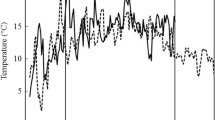Summary
Differences in response to photoperiod and vernalization and genetic variation independent of photoperiod and vernalization (earliness per se), affecting time of ear emergence of wheat, were identified in controlled environment experiments with 33 varieties of diverse geographical origin. The results were compared with an analysis of time of ear emergence of 10409 T. aestivum accessions from the USDA Small Grain Collection grown from autumn sowings in Pendleton, Oregon, and spring sowings in Fargo, North Dakota. The effect of differences in photoperiod and vernalization sensitivity on time of ear emergence was similar to the effect of earliness per se, both under controlled environment conditions and in the field. Most of the accessions from low latitude regions reached ear emergence rapidly owing to their insensitivity to photoperiod and vernalization and earliness per se factors accelerating ear emergence. Lateness was common among accessions from Northern Europe, Afghanistan and Turkey, which was due to sensitivity to photoperiod and vernalization, and to earliness per se factors delaying ear emergence. The physiological basis of earliness per se is discussed.
Similar content being viewed by others
References
Arnon I., 1972. Wheat. In: Crop production in dry regions. Vol. 2. Systematic treatment of the principal crops. Leonard Hill, London. p. 1–72.
Busch R. H. & D. D. Chamberlain, 1981. Effects of daylength response and semi-dwarfism on agronomic performance of spring wheat. Crop Sci. 21: 57–60.
Ford M. A., R. B. Austin, W. J. Angus & G. C. M. Sage, 1981. Relationships between the responses of spring wheat genotypes to temperature and photoperiodic treatment and their performance in the field. J. Agric. Sci., Camb. 96: 623–634.
Gotoh T., 1977. Varietal differences in photoperiodic and thermal responses of wheat. Jap. J. Breed. 27: 57–69 (Jap., English summ.).
Gotoh T., 1979. Factors determining varietal differences of heading behavior of wheats. Jap. Agric. Res. Q. 13: 222–225.
Halse N. J. & R. N. Weir, 1970. Effects of vernalization, photoperiod and temperature on phenological development and spikelet number of Australian wheat. Aust. J. Agric. Res. 21: 383–393.
Hoogendoorn J., 1984. A comparison of different vernalization techniques in wheat (Triticum aestivum L.). J. Plant Phys. 116: 11–20.
Hoogendoorn J., 1985a. A reciprocal F1 monosomic analysis of the genetic control of time of ear emergence, number of leaves and number of spikelets in wheat (Triticum aestivum L.). Euphytica 34: 545.
Hoogendoorn J., 1985b. The basis of variation in date of ear emergence under field conditions among the progeny of a cross between two winter wheat varieties. J. Agric. Sci., Camb. 104: 493–500.
Hunt L. A., 1979. Photoperiodic responses of winter wheats, from different climatic regions. J. Plant Breed. 82: 70–80.
Law C. N. & R. Scarth, 1984. Genetics and its potential for understanding the action of light in flowering. In: D. Vince-Prue (Ed.), Light and the flowering process. Academic Press, London. p. 193–209.
Law C. N., J. W. Snape & A. J. Worland, 1981. Intra-specific chromosome manipulation. Phil. Trans. R. Soc. London B. 292: 509–518.
Qualset C. O. & Y. P. Puri, 1973. Heading time in a world collection of durum wheat: photo-and thermal-sensitivity related to latitudinal responses and geographic origins. In: GscG. T. Scarascia-Mugnozza (Ed.). Genetics and breeding of durum wheat. Univ. Bari, Italy: 165–178.
Rahman M. S. & J. H. Wilson, 1978. Determination of spikelet number in wheat. III. Effect of varying temperature on ear development. Austr. J. Agric. Res. 29: 459–467.
Riddell J. A. & G. A. Gries, 1958. Development of spring wheat. II. The effect of temperature on responses to photoperiod. Agron. J. 50: 739–742.
Scarth R. & C. N. Law, 1984. The control of the daylength response in wheat by the group 2 chromosomes. J. Plant Breed. 92: 140–150.
Syme J. R., 1968. Ear emergence of Australian, Mexican and European wheats in relation to time of sowing and their response to vernalization and daylength. Austr. J. Exp. Agric. Anim. Husb. 8: 578–581.
Wall P. C. & P. M. Cartwright, 1974. Effects of photoperiod, temperature and vernalization on the phenology and spikelet numbers of spring wheats. Ann. Appl. Biol. 76: 299–309.
Yasuda S. & H. Shimoyama, 1965. Analysis of internal factors influencing the heading time of wheat varieties. Ber. Ohara Inst. Landw. Biol., Okavama Univ. 13: 23–38.
Zeven A. C. & N. Ch. Zeven-Hissink, 1975. Genealogies of 14000 wheat varieties. Netherlands Cereals Centre (NGC), Wageningen, & CIMMYT, Mexico: 121 p.
Author information
Authors and Affiliations
Rights and permissions
About this article
Cite this article
Hoogendoorn, J. The physiology of variation in the time of ear emergence among wheat varieties from different regions of the world. Euphytica 34, 559–571 (1985). https://doi.org/10.1007/BF00022955
Received:
Issue Date:
DOI: https://doi.org/10.1007/BF00022955




